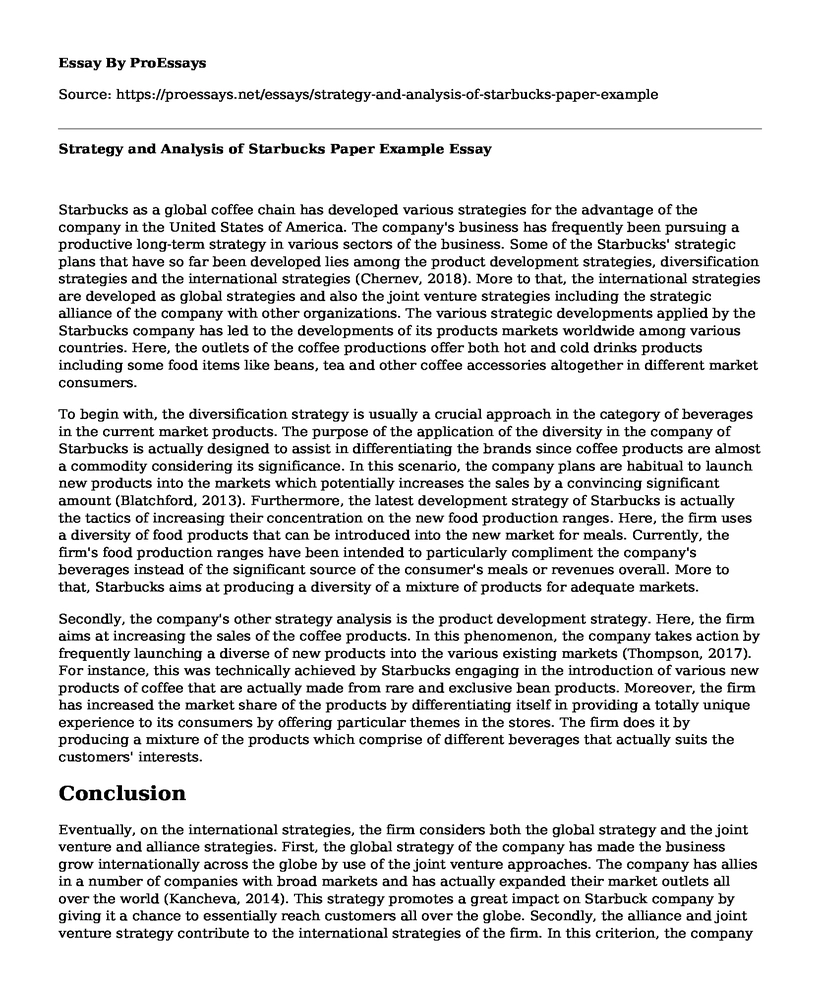Starbucks as a global coffee chain has developed various strategies for the advantage of the company in the United States of America. The company's business has frequently been pursuing a productive long-term strategy in various sectors of the business. Some of the Starbucks' strategic plans that have so far been developed lies among the product development strategies, diversification strategies and the international strategies (Chernev, 2018). More to that, the international strategies are developed as global strategies and also the joint venture strategies including the strategic alliance of the company with other organizations. The various strategic developments applied by the Starbucks company has led to the developments of its products markets worldwide among various countries. Here, the outlets of the coffee productions offer both hot and cold drinks products including some food items like beans, tea and other coffee accessories altogether in different market consumers.
To begin with, the diversification strategy is usually a crucial approach in the category of beverages in the current market products. The purpose of the application of the diversity in the company of Starbucks is actually designed to assist in differentiating the brands since coffee products are almost a commodity considering its significance. In this scenario, the company plans are habitual to launch new products into the markets which potentially increases the sales by a convincing significant amount (Blatchford, 2013). Furthermore, the latest development strategy of Starbucks is actually the tactics of increasing their concentration on the new food production ranges. Here, the firm uses a diversity of food products that can be introduced into the new market for meals. Currently, the firm's food production ranges have been intended to particularly compliment the company's beverages instead of the significant source of the consumer's meals or revenues overall. More to that, Starbucks aims at producing a diversity of a mixture of products for adequate markets.
Secondly, the company's other strategy analysis is the product development strategy. Here, the firm aims at increasing the sales of the coffee products. In this phenomenon, the company takes action by frequently launching a diverse of new products into the various existing markets (Thompson, 2017). For instance, this was technically achieved by Starbucks engaging in the introduction of various new products of coffee that are actually made from rare and exclusive bean products. Moreover, the firm has increased the market share of the products by differentiating itself in providing a totally unique experience to its consumers by offering particular themes in the stores. The firm does it by producing a mixture of the products which comprise of different beverages that actually suits the customers' interests.
Conclusion
Eventually, on the international strategies, the firm considers both the global strategy and the joint venture and alliance strategies. First, the global strategy of the company has made the business grow internationally across the globe by use of the joint venture approaches. The company has allies in a number of companies with broad markets and has actually expanded their market outlets all over the world (Kancheva, 2014). This strategy promotes a great impact on Starbuck company by giving it a chance to essentially reach customers all over the globe. Secondly, the alliance and joint venture strategy contribute to the international strategies of the firm. In this criterion, the company forms cooperation with other business companies that are related to the firm for the purposes of opening franchises and stores in various countries across the globe (Dixon, 2013). However, some of the examples of the partnerships made between Starbuck and other companies are; the joint venture between Starbuck and China's Beijing Mei Da coffee company, Starbucks and Julia Dixon on Prezi and also Starbucks and TATA Alliance market strategy among others.
References
Blatchford, J. (2013). Starbucks- Related Diversification. Manifested Marketing-Marketing Blog. Retrieved from https://manifestedmarketing.wordpress.com/2013/10/07/starbucks-related-diversification/
Chernev, A. (2018). Strategic Marketing Management. Cerebellum Press.
Dixon, J. (2013). Starbucks and Strategic Alliance. Prezi. Retrieved from https://prezi.com/mok0exinsjne/starbucks-and-strategic-alliance/
Kancheva, M. (2014). Starbucks-TATA Alliance Marketing Strategy. University of Bath. Retrieved from https://www.readkong.com/page/starbucks-tata-alliance-marketing-strategy-5433497
Thompson, A. (2017). Starbucks Coffee's Generic and Intensive Growth Strategies. Panmore Institute. Retrieved from http://panmore.com/starbucks-coffee-generic-strategy-intensive-growth-strategies
Cite this page
Strategy and Analysis of Starbucks Paper Example. (2022, Oct 20). Retrieved from https://proessays.net/essays/strategy-and-analysis-of-starbucks-paper-example
If you are the original author of this essay and no longer wish to have it published on the ProEssays website, please click below to request its removal:
- Collaboration Software Tools
- Operations and Information Management - Essay Example
- Market Research and Strategies Paper Example
- Annotated Bibliography on American Federation of Labor
- Essay Example on Competitive Advantage: Leveraging Porter's 5 Forces Model
- Essay on Organizational Behavior: Uniting People, Resources and Planning for Optimal Results
- Change Management: Needed for Outdated Orgs & Reduced Responsiveness - Essay Sample







